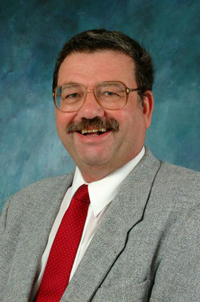 UNMC researcher J. Graham Sharp, Ph.D., answers questions about his work, life and interests.
UNMC researcher J. Graham Sharp, Ph.D., answers questions about his work, life and interests.
NOTE: This profile is part of a series highlighting the 25 researchers who were named UNMC Distinguished Scientists for 2006. Each of these researchers will be profiled in UNMC Today leading up to a March 12 ceremony to recognize their achievements.
- Name: J. Graham Sharp, Ph.D.
- Title: Professor, Genetics, Cell Biology & Anatomy, Radiology, and Radiation Oncology, College of Medicine
- Joined UNMC: 1973
- Hometown: Todmorden (near Halifax), West Yorkshire, England
Describe your research in 25 words or less (in layman’s terms, please).
I am interested in how stem cells, which can replicate themselves, as well as specialize into many functional cell types, are regulated. I would like to exploit this knowledge to determine why stem cells decline with age and to improve their use for tissue repair and regeneration.
How did you decide to pursue this area of research?
A series of “accidental” interactions with some remarkable individuals, in particular, Professor David Brynmor Thomas, who involved me in transplantation and Professor Sir Nick Wright, who emphasized the need to study stem cells for transplantation.
When did you realize you were interested in research?
When in high school, my nickname was “Professor” and this was not entirely a compliment.
What are the greatest challenges in research today?
The greatest challenges are in attracting and training bright young researchers of the future. There have to be concerns over lack of rigor in the educational system, especially science education. Consequently, when combined with restrictions and regulations, science emphasis is shifting to other nations and the impact on innovation and productivity in the USA is a concern.
Best advice for new researchers?
Seek out the best, most rigorous training you can obtain. Know the literature. Apply the most up-to-date, effective techniques and analyses and prove that you can compete nationally for grant funding.
When an experiment stalls, what drives you to continue on?
Generally our experiments do not “stall.” They tend to produce unexpected results, i.e., instead of “x” or “y” we get “z.” This indicates we know less about the system than we thought. This is the basis for progress because it demands that we critically examine our beliefs and better define our future experiments.
Who has been your greatest teacher?
I have been fortunate to interact with a number of remarkable individuals over the years and all have contributed some components to education and philosophy.
Tell us about your family and hobbies outside the lab.
I have been married for 33 years. We have two sons, three grand-daughters, two cats and a dog, so there is not much time for hobbies, but I enjoy reading, fishing and traveling (other than for work).
Globally, describe the most notable research achievement ever?
The formulation of the special and general theories of relativity (Einstein).
Clarify a common misconception about research.
Those created by “instant science sound bite,” often simplified to the point of being erroneous, propounded by the media on “breaking news.” This distorts the scientific process, often is a pile of crap and only serves to confuse, not educate, the public.
What would you tell a student interested in a research career?
It is an opportunity to explore for new knowledge, to challenge yourself and be your own “boss” (sort of). At the same time, it is a tough row to hoe in today’s world. Worth it, if you are successful, so you have to be driven. If you do not enjoy it, get out and do something else.
List three things few people know about you.
- My greatest adversaries are not other researchers, but brown trout.
- I enjoy reading about science, history and politics and, in particular, spies, since some of my former mentors and colleagues may have had connections to nefarious activities (the Apostle’s Club at Cambridge, espionage and the Manhattan Project, etc.).
- Many years ago I worked in an iron foundry, so I enjoyed visiting the Nassawango and Hopewell furnaces which were the earliest blast furnaces in the United States.